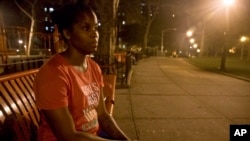Six weeks after her arrival at Rikers Island, an argument over who should clean a jailhouse shower sent Candie Hailey to solitary confinement, known as “the bing.”
It was the first time, but it would not be the last.
A month later, records show, she cursed and spit at a guard and resisted when she was put in a hold. Ninety-five days in the bing. She later got 70 days for cursing at an officer, splashing the guard with toilet water and refusing to stop. Among other infractions: fighting (40 days), disrespect of staff (30 days) and blocking her cell window (15 days).
Of her first 29 months in jail, Hailey served about 27 alone in a 6-by-10-foot cell, with a bed, a toilet and a few books to pass the time. When she did go outside, it was just for one hour in 24. And she had yet to be tried for any crime, let alone convicted.
At least eight times in the course of her more than three-year incarceration, she would be taken to the hospital after suicide attempts in solitary that included trying to swallow hair remover product, pills and the chemicals inside an instant ice pack, banging her head on a wall and trying to electrocute herself by putting a phone cord in her cell's toilet.
Hailey could not abide solitary confinement. But that was the only place her jailers felt they could put her.
Candie Hailey's wretched stay at Rikers, detailed in official documents and hours of interviews, is a case study in solitary confinement and its consequences.
Many criminal justice experts say officials too often rely on solitary to punish inmates, disregarding the effect on troubled men and women like Hailey. Research has shown that solitary can be psychologically distressing, especially for prisoners who go into it with preexisting mental illnesses.
Even though long-term use of isolation is increasingly being challenged _ in statehouses, the courts and even by President Barack Obama, who last month banned its use for juveniles as punishment for low-level infractions in federal prisons _ it's still the most common correctional tool nationwide used to keep order.
Hailey, who was diagnosed at Rikers with a borderline character disorder, mood disorder and anti-social personality disorder, quickly adopted a perverse survival strategy: Act out and you get out, if only temporarily for treatment.
“I would take the feces and I put it all over me,” she recalls. “I said, `If you're gonna treat me like a dog, I'm gonna act like one.”'
___
Hailey believed she was treated unfairly from the moment of her arrival at Rikers' 800-bed, all-women's Rose M. Singer Center, Rosie's, as it's called.
Her arrest on attempted murder charges following a 2012 fight with three other women was widely publicized, with at least one city tabloid seizing on the fact that one of the women's 4-month-old baby girl was left with a skull fracture and a deep cut above her eye. Guards and fellow inmates gave her a scurrilous nickname: “baby killer.”
When Hailey was examined after the eight suicide attempts, psychiatrists who saw her came to the same conclusion: She was manipulative, a malingerer, intentionally hurting herself to escape solitary. The cause of this behavior, they said, was her underlying personality disorder.
“I'm being treated as a criminal, but I am the victim,” she told a mental health worker.
But Hailey wasn't a candidate for units for the most seriously mentally ill because she didn't have a diagnosis of severe depression, bipolar disorder or schizophrenia. So, more often than not, after her suicide attempts she was placed on suicide watch and sent back to the bing. The only mental health care she received in solitary consisted of brief consultations at her cell's door.
“I can't endure this abuse evermore,” she wrote in a handwritten suicide note to her father in the summer of 2014. “The truth will come to light, while death shall set me free.”
Hailey's monthlong trial last May ended with a verdict of not guilty. Hailey was free to return to the Bronx.
Jail officials wouldn't discuss Hailey's case specifically. But city Corrections Department spokeswoman Eve Kessler said officials have reduced the number of inmates serving their time in solitary by about two-thirds in the past two years, noting that “everyone in our custody deserves to be treated safely and humanely.”
___
In more than three years Hailey spent in jail, she spent 2 1/3 years in solitary. And in the nine months since she was freed, she has struggled to break free from the trauma of her confinement.
“Honestly I think I'd be better off in jail,” the now-32-year-old Hailey said after yet another failed trip to court to regain custody of her two children. “It's like a nightmare, like everyone's out there trying to get me.”
She had reunited with her younger sisters and father and promptly dissociated from them; struggled to regain her welfare benefits and strove to complete a still-unresolved divorce.
Housing has been a continuing struggle. She cycled out of two different city shelters, got locked out of a $100-per-week room in the Bronx. By December, she had resorted to riding subway trains through the night. Twice since her release, she's tried to kill herself. And for months she stopped attending weekly counseling sessions
Just before the end of the year, Hailey gained placement in another apartment for people with mental health problems and agreed to return to counseling. But she was still fearful her cycle of problems would never end.
“I would say I've been through hell and back,” she said. “My soul died but my body is alive.”









